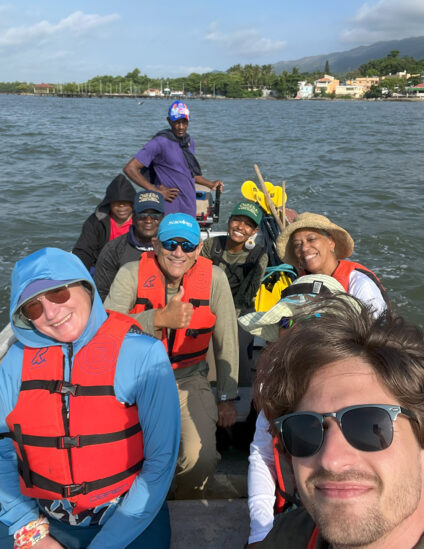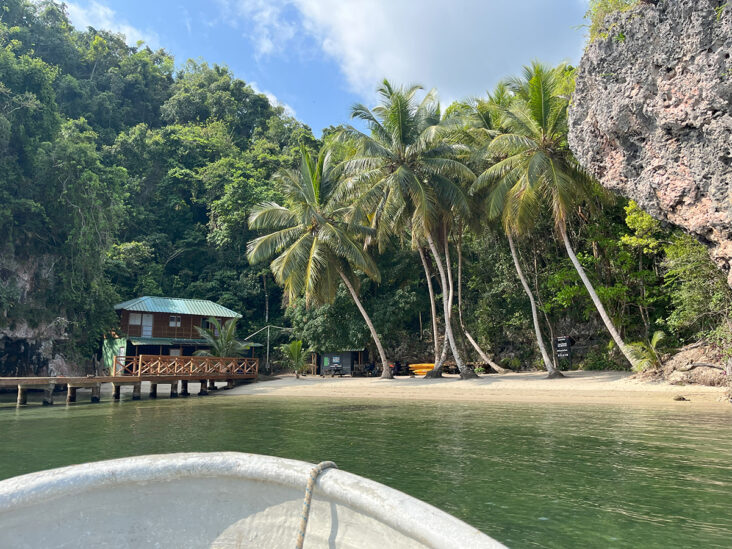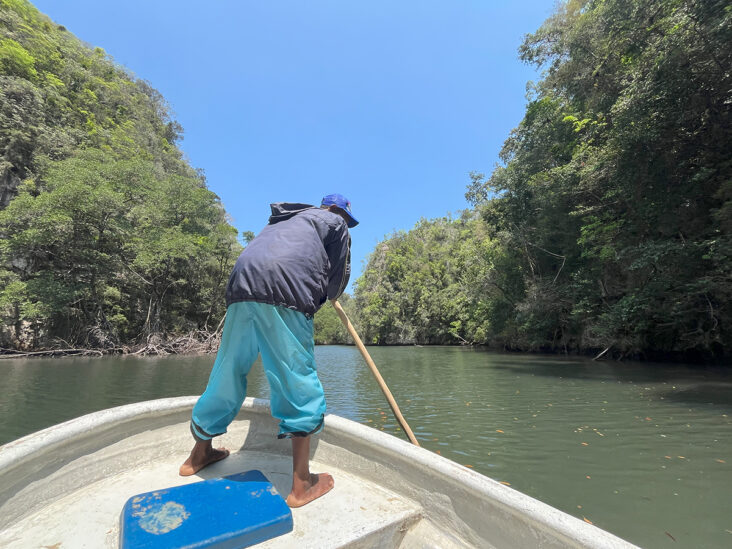Paddling for the planet in the Dominican Republic
Max Rojas-Domke joined our team late last year as our new individual giving manager. This month, on his first-ever visit to a Seacology project site, he and other staffers met with our Dominican Republic field representative, project partners, and funders of our nationwide initiative to protect the DR’s threatened mangrove forests.
The final day of the trip left a lasting impression on Max. The group visited a project where Seacology is working with former fishermen-turned-ecotour operators to protect the beautiful wetlands of Los Haitises National Park.
This trip was just a smaller visit for staff to check on existing projects, but these kinds of unique ecotourism experiences are available to our supporters who join a Seacology Expedition. These excursions to some of the world’s most stunning islands include visits to Seacology project sites, where Seacology supporters can see for themselves the impact that our work—and their support for it—is having.
Sun, sand, sparkling water, and an endangered manatee—a great day for the finale of my first visit to a Seacology project! Our group woke up with the sunrise, chasing the warmth during our drive to the town of Sanchez.

Arriving at a local dock in the mid-morning, we greeted our boat’s captain and first mate, former fishermen who are now tour guides and ferrymen, as part of Seacology’s initiative to develop non-fishing jobs in the local economy. They act as de facto guardians of the huge, intact mangroves of San Lorenzo Bay.
The bay water was deep blue and calm. Intermittent chatter broke up the sound of our motor cutting through the waves, while the sun and salt did their best to preserve us.
Los Haitises National Park is a large wetland area made up of inlets, bays, and bays-within-bays. Seacology’s project here, at San Lorenzo Bay, ensures the protection of nearly 3,000 acres of protected mangroves, in exchange for the funding of an office for the local fishing cooperative to support its ecotourism business. We believe that as efforts to protect the park become more commonplace, increased appreciation for Los Haitises will sway opinions toward greater conservation efforts.
As we neared its coast, monoliths made of ancient coral skeletons watched our boat with timeless indifference. They grew in number toward the shore, before we disembarked in front of the park’s ranger station.


Sitting in the sand, we ate sandwiches we’d brought from the hotel. Lunch was interrupted as a tour guide on break called out to all, manatee! It had floated over to the small bay where we had docked and was grazing on the protected seagrass. We watched as it peeked its nose out for air before drifting away.

Next, we explored a small cave system near the station. The Taíno, the indigenous peoples of the Dominican Republic, had carved faces into the walls here. Their creators now gone, these masks indicated one of the earliest human settlements on the island. The cave systems cooled us during our circuitous walk, and we re-boarded our boat energized for kayaking and walking in the 90-degree sun.
We slowly cruised past the park’s shoreline, heading to a small delta. Here, we moored our motorboat and broke into pairs for kayaking. With our guide ahead of us, we navigated the labyrinth of mangroves. A natural nursery, the park is home to many juvenile fish that will go on to populate the nearby reefs. Our guide lamented how the fish population had decreased noticeably in recent years, with fishermen taking more time to catch less. It was hard to fathom—a land seemingly teeming with life yet experiencing mass death.
We marveled at mangroves and watched crabs pick at their food while frigatebirds and pelicans circled overhead. The air was hot and the water was cool, and it made me feel so grateful and small. This forest was still very much alive.

As we returned to the kayak dock, one of our guides pointed out a trail that led into the jungle.
“It’s about an hour-long walk and breaks out on the other side of the water. We could go, but the boat would have to meet us on the other side.”
Some of us broke off to try a taste of the path. We trekked for a short while before coming upon another cave system. We climbed through cool limestone as the cave opened and then closed around us.

Breaking out of the earth, we returned to our kayaks and motorboat. Our reunited team returned to the ranger station before heading toward our initial dock. Nio, the boat driver, took us along the park’s shoreline so that we could take in more of the mangroves. It stretched into the distance, a line of green trees climbing over mountains of limestone. Islets, full of birds, littered the water near shore. Eventually, we turned into the bay and headed back to shore.
Once back, we said goodbye to our field rep, Leida, who was happy to have shared her country’s culture and natural splendor with us for the past week. She expressed her gratitude for the work Seacology had sponsored and happily informed us that she was already in the early stages of identifying future projects.
Visiting a Seacology project is a deeply unique and impactful experience. It’s easy to understand that a project helping both the people and the environment is a “win-win,” but seeing in person how connected these aspects are cannot be expressed in words.

The fishermen who had gotten a Seacology grant were able to switch their careers to a more sustainable and profitable role, becoming stewards of their historic waters. The agreement to help preserve the park for decades gives them an environment in which they can build their income as they protect the source of that income—the mangroves and wildlife we all value. Watching these parts come together to improve each other struck me deeply. The tools to meaningfully protect both island creatures and cultures do exist—they’re Seacology’s open secret.
 Max Rojas-Domke is Seacology’s individual giving manager.
Max Rojas-Domke is Seacology’s individual giving manager.

